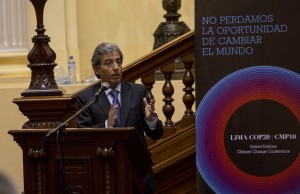This December, 195 nations plus the European Union will meet in Lima for two weeks for the crucial U.N. Conference of the Parties on Climate Change, known as COP 20. The hope in Lima is to produce the first complete draft of a new global climate agreement.
However, this is like writing a book with 195 authors. After five years of negotiations, there is only an outline of the agreement and a couple of ‘chapters’ in rough draft.

The deadline is looming: the new climate agreement to keep climate change to less than two degrees C is to be signed in Paris in December 2015.
“A tremendous amount of work has to be done in Lima,” said Erika Rosenthal, an attorney at Earthjustice, an environmental law organisation and advisor to the chair of the Alliance of Small Island States (AOSIS).
Climate science is clear that global CO2 emissions must begin to decline before 2020 – otherwise, preventing a 2C temperature rise will be extremely costly and challenging.
“Time is short after Lima and Paris cannot fail,” said Rosenthal. “Paris is the key political moment when the world can decisively move to reap all the benefits of a clean, carbon-free economy.”
Success in Lima will depend in part on Peru’s Environment Minister Manuel Pulgar-Vidal. As official president of COP 20, Pulgar-Vidal’s determination and energy will be crucial, most observers believe.
Climate change is a major issue in Peru, since Lima and many other parts of the country are dependent on freshwater from the Andes glaciers. Studies show they have lost 30 to 50 percent of their ice in 30 years and many will soon be gone.
Pulgar-Vidal has said he expects Lima to deliver a draft agreement, although it may not include all the chapters. The full draft with all the chapters needs to be completed by May 2015 to have time for final negotiations.
The future climate agreement, which could easily be book-length, will have three main sections or pillars: mitigation, adaptation and loss and damage. The mitigation or emissions reduction pillar is divided into pre-2020 emission reductions and post-2020 sections.
This December, 195 nations plus the European Union will meet in Lima for two weeks for the crucial U.N. Conference of the Parties on Climate Change, known as COP 20. The hope in Lima is to produce the first complete draft of a new global climate agreement.
However, this is like writing a book with 195 authors. After five years of negotiations, there is only an outline of the agreement and a couple of ‘chapters’ in rough draft.
The deadline is looming: the new climate agreement to keep climate change to less than two degrees C is to be signed in Paris in December 2015.
“A tremendous amount of work has to be done in Lima,” said Erika Rosenthal, an attorney at Earthjustice, an environmental law organisation and advisor to the chair of the Alliance of Small Island States (AOSIS).
Climate science is clear that global CO2 emissions must begin to decline before 2020 – otherwise, preventing a 2C temperature rise will be extremely costly and challenging.
“Time is short after Lima and Paris cannot fail,” said Rosenthal. “Paris is the key political moment when the world can decisively move to reap all the benefits of a clean, carbon-free economy.”
Success in Lima will depend in part on Peru’s Environment Minister Manuel Pulgar-Vidal. As official president of COP 20, Pulgar-Vidal’s determination and energy will be crucial, most observers believe.
Climate change is a major issue in Peru, since Lima and many other parts of the country are dependent on freshwater from the Andes glaciers. Studies show they have lost 30 to 50 percent of their ice in 30 years and many will soon be gone.
Pulgar-Vidal has said he expects Lima to deliver a draft agreement, although it may not include all the chapters. The full draft with all the chapters needs to be completed by May 2015 to have time for final negotiations.
The future climate agreement, which could easily be book-length, will have three main sections or pillars: mitigation, adaptation and loss and damage. The mitigation or emissions reduction pillar is divided into pre-2020 emission reductions and post-2020 sections.
By Stephen Leahy • UXBRIDGE, Canada, (IPS)
